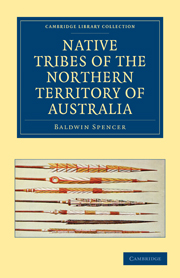Book contents
- Frontmatter
- Preface
- NOTE
- Contents
- LIST OF ILLUSTRATIONS
- CHAPTER I INTRODUCTION
- CHAPTER II SOCIAL ORGANISATION AND MARRIAGE REGULATIONS
- CHAPTER III INITIATION CEREMONIES
- CHAPTER IV TOTEMIC SYSTEMS AND TOTEM GROUPS
- CHAPTER V SACRED STICKS, BULL-ROARERS, AND CEREMONIAL OBJECTS
- CHAPTER VI BURIAL AND MOURNING CEREMONIES
- CHAPTER VII MAGIC AND MEDICINE
- CHAPTER VIII BELIEFS IN REGARD TO THE ORIGIN OF CHILDREN
- CHAPTER IX TRADITIONS CONCERNING IMBEROMBERA, THE GREAT ANCESTOR, AND ALSO OTHER ANCESTORS OF THE KAKADU NATION
- CHAPTER X VARIOUS TRADITIONS, CUSTOMS, AND BELIEFS
- CHAPTER XI FOOD RESTRICTIONS
- CHAPTER XII WEAPONS AND IMPLEMENTS
- CHAPTER XIII CLOTHING AND ORNAMENT
- CHAPTER XIV DECORATIVE ART
- APPENDIX
- GLOSSARY OF NATIVE TERMS
- INDEX
- Plate section
- Plate section
- Frontmatter
- Preface
- NOTE
- Contents
- LIST OF ILLUSTRATIONS
- CHAPTER I INTRODUCTION
- CHAPTER II SOCIAL ORGANISATION AND MARRIAGE REGULATIONS
- CHAPTER III INITIATION CEREMONIES
- CHAPTER IV TOTEMIC SYSTEMS AND TOTEM GROUPS
- CHAPTER V SACRED STICKS, BULL-ROARERS, AND CEREMONIAL OBJECTS
- CHAPTER VI BURIAL AND MOURNING CEREMONIES
- CHAPTER VII MAGIC AND MEDICINE
- CHAPTER VIII BELIEFS IN REGARD TO THE ORIGIN OF CHILDREN
- CHAPTER IX TRADITIONS CONCERNING IMBEROMBERA, THE GREAT ANCESTOR, AND ALSO OTHER ANCESTORS OF THE KAKADU NATION
- CHAPTER X VARIOUS TRADITIONS, CUSTOMS, AND BELIEFS
- CHAPTER XI FOOD RESTRICTIONS
- CHAPTER XII WEAPONS AND IMPLEMENTS
- CHAPTER XIII CLOTHING AND ORNAMENT
- CHAPTER XIV DECORATIVE ART
- APPENDIX
- GLOSSARY OF NATIVE TERMS
- INDEX
- Plate section
- Plate section
Summary
Vocabularies and Notes on the Languages of the Kakadu, Melville Island and Warrai Tribes, together with a List of Numerals in Eighteen Tribes.
One of the most difficult things to do whilst working amongst Australian tribes is to attempt not only to learn to speak but to write down their languages or dialects. My experience has been that there is considerable variation in the way in which different natives pronounce the same word; that even the same native pronounces it slightly differently at different times; that the number of syllables in a word depends upon whether the native speaks slowly or quickly, and lastly, that, in many cases, two white men, hearing the same word pronounced by a native, would, most probably, write it down in slightly different ways. It is, for example, quite impossible, very often, to say whether, in any word a particular consonant should be written as k or g, b or p, d or t, as the case may be; or whether, amongst the vowels, a word should be spelt with a short a or u. The word Arunta can, with equal correctness, be spelt Arunta, Arunda, Aranta or Aranda, in all of which ways it is pronounced by natives in different parts.
It is quite possible to acquire a certain knowledge, sufficient to hold converse with the natives and to be able to understand practically everything of importance, but to get beyond this and gain an accurate knowledge of the finer points is the work of years.
- Type
- Chapter
- Information
- Native Tribes of the Northern Territory of Australia , pp. 441 - 484Publisher: Cambridge University PressPrint publication year: 2010First published in: 1914

